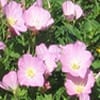 By Brenda Beust Smith
By Brenda Beust Smith
I had an extraordinary experience recently. I attended the Wildscapes Workshop presented annually by the Native Plant Society of America/Houston Chapter (this year in conjunction with Texas Parks & Wildlife and the Houston Zoo, which provided the venue). On the agenda were many experts, all of whom were outstanding. But two – environmental attorney Jim Blackburn (whom we all know from the Rollover Pass lawsuits) and Jamie Gonzales of the Katy Prairie Conservancy – gave me for the first time a truly global view of changes that, ultimately, are going to have a major impact on us home gardeners.
Both focused, of course, on the need to use more native plants in our landscapes. Personally, I prefer to expand that recommendation to include “Gulf Coast-hardy” plants, which may or may not be native to Texas. After all, we are closer in ecology to Southern Louisiana than to any other part of Texas. And, besides, “natives” is sometimes confusing term. The important this is: how carefree, drought-tolerant, heavy rain-tolerant, heat-tolerant and maintenance-free is the plant HERE?
True, native plants “well adapted to local environment” (a qualifying condition too often left off plant recommendations) are best for our landscape as they provide multiple benefits to local wildlife.
But good, low water, heat/cold-tolerant, low-maintenance “Gulf Coast-hardy” selections can be used with natives to, shall we say, compensate for the natives’ sometimes less-than-attractive down times.
That aside, my real enthusiasm came from both Jim’s and Jamie’s elaborations on the now-many potential profits for big business in becoming more ecology-friendly in all they do. The range of both already- and potentially-$$$ profitable directions across the globe is so encouraging.
Landscape aspects in particular are now far more government-ordinance-mandated for construction projections — with noticeable emphasis on water-guzzling St. Augustine lawns. With money-savings as their primary goal (and avoidance of penalties for exceeding water allotments), businesses are increasingly reducing the use of St. A. It’s a growing trend now long past initial stages.
I never understood using St. Augustine on a beach lawn. St. Augustine uses more water on a typical suburban lawn than all the other landscape plants combined. And we’re talking regular soil; not the fast-draining sand that comprises our beach lawns.
St. Augustine wants to go dormant in the summer. The only way to keep it green and beautiful is with excessive watering and fertilizing. The fertilizers and other landscape chemicals that run off your yard when it rains are increasingly polluting Galveston Bay. That’s a whole other story — and you can easily confirm facts and figures online. If you love Galveston Bay, for whatever reason, you need to be concerned!
As counties all around the Greater Houston/Galveston area have already discovered, water rationing is no longer a future prospect. It’s a reality in our all-too-frequent drought-dominated summers. It will become even more so in the future.
The State of Texas-issued water allotments to businesses FAR exceed the available statewide water supply — even with our recent heavy rains. If and when they start cashing in these allotments — as they’re legally entitled to do — home lawns will feel the impact. Best to start changing now.
Someone, somewhere — I know not who — decreed that the perfect “look” for the perfect home landscape is a big green lawn with a few gardens set off with borders. We all bought into it. And now residential developers are using a variety of tactics to ensure we don’t veer from this view in ways that might affect their investments.
There’s nothing wrong with St. Augustine as “a plant.” A small lawn is cooling in summer, it’s a great place for kids to play, it’s soft to walk on, and it does beautifully set off other plantings.
But it doesn’t need to be — and SHOULDN’T be — the focal point, the largest planting, of any landscape…not with our current water problems and the damage we are causing in Galveston Bay to keep our lawns beautiful in summer!
One solution that might not be quite so painful: a (reduced-size) mixed bermuda/St. Augustine lawn. Bermuda is green in the summer and comes on if St. Augustine is allowed to go dormant like it wants to. St. Augustine is green in the spring and fall.
At the beach, numerous low growing weeds easily fill in dead areas if kept mowed so they spread sideways instead of growing upward. But they also will quickly start producing flowers on very low growing stalks. Sure they may looks parse at times. But you’re at the beach! Not in some pristine, every-yard-looks-alike subdivision.
A mowed lawn looks like a mowed lawn, no matter what the “grass” unless you get down and look closely. How often do you actually LOOK at your lawn, except to see if it needs to be mowed?
Help with reducing the size of a lawn abounds. One great source: http://tcwp.tamu.edu/watersmart-is-the-best-strategy/. But there are so many more. Just Google: Reduce Lawn Size
It’s the wave of the future all over this nation — so might as well get prepared. It’s coming down from the top as big businesses are forced to become more environmentally aware. The increased avenues of profit now available, and projected, in this trend are speeding its progress.
It’s coming up from the bottom up, too, as schools are putting in more and more habitat gardens, and using them to teach not only various curriculums but, in the process, how inter-related we all are with our environment.
A good friend’s 5-year-old granddaughter recently informed her that she would have more butterflies in her yard if she just had more flowers and less grass. He learned that in school.
Do you want your children and grandchildren visiting at the beach criticizing your landscape for the size of your lawn compared to flowers and other plantings that benefit birds and butterflies? These days, they’re increasingly more likely to.
And, now, even Pope Frances has issued a higher view of the need for us to change.
Pictured here are some of the beautiful Bolivar Peninsula wildflowers and Gulf Coast Hardies that, if you will look around, you’ll see so many smart peninsula gardeners have already incorporated right into their landscapes. True lazy gardening! [Brenda Beust Smith photos]
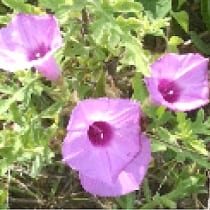 Beach Morning Glory |
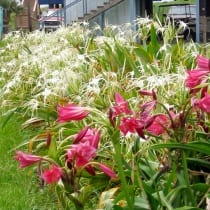 Pink Crinums and White Spider Lilies |
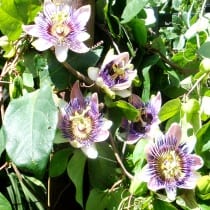 Passionvine |
 Lantana |
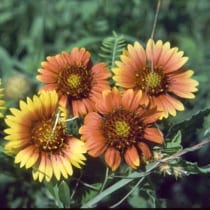 Gaillardia |
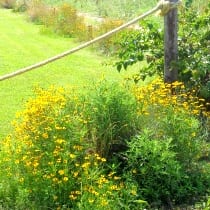 Coreopsis |
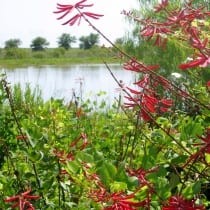 Coral Bean |
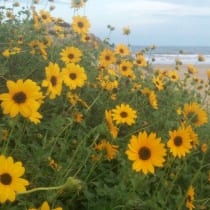 Black Eyed Susans |
Brenda is a columnist for the “Lazy Gardener & Friends Garden Newsletter”
(www.lazygardenerandfriends.com or see link on Crystal Beach Local News).
Email Brenda at [email protected]
[10-12-2015]

 Posted in
Posted in 























